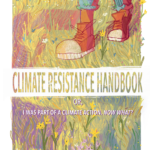Goals
• To demonstrate the greenhouse effect by showing how carbon dioxide (or equivalents, sometimes referred to as CO2e) in the atmosphere traps heat and insulates the Earth;
• To show that human activities affect the concentration of greenhouse gases in the atmosphere;
• To teach how structural versus individual lifestyle changes impact the atmosphere.
Materials
Action cards representing human actions that affect CO2e levels in the atmosphere. (Download Sample Action Cards, and free to add your own. Here are Handouts on emissions.)
Procedure
Draw two concentric circles on the ground, a little over ½ meter (2 feet) in diameter, and a larger one about 5 meters (16 feet) in diameter. The smaller circle represents the Earth and the larger one represents Earth’s atmosphere. (You can also use rope or tape to mark the circles.)
The game is played in several rounds. For round one, get two participants to be CO2e molecules, and place them anywhere in the Earth’s “atmosphere.” Once they are in the atmosphere they cannot move their feet. The rest of the people are sunbeams representing energy from the sun.
(NOTE: CO2e, or carbon dioxide equivalent, is a standard unit for measuring carbon footprints. The idea is to express the impact of each different greenhouse gas in terms of the amount of CO2 that would create the same amount of warming. This is a way of including other greenhouse gases.)
The object of the game is for the sunbeams to enter the atmosphere, tag the Earth (by touching the inner circle with a foot or hand) and then escape the atmosphere without getting tagged by a CO2e molecule. Sunbeams who are tagged must stay standing still in the atmosphere. Those who avoid being tagged bounce back out of the atmosphere into space.
Each round lasts approximately 30 seconds and during that time the sunbeams try to tag the Earth only once. This simulation recreates the greenhouse effect: energy from the sun is trapped as heat by CO2e and other gases and particles in the atmosphere.
After the first round, have the escaped sunbeams form a circle around the atmosphere to check how much energy has been trapped. Discuss how this may affect the temperature of the planet.
Explain that a certain amount of CO2e is necessary to keep the planet consistently warm enough to support life. During the first round, most of the energy will have escaped the atmosphere because CO2e levels are low. Before continuing the game, clear all the trapped sunbeams out of the atmosphere.
For the second round, increase the number of CO2e molecules in the atmosphere. Do this by reaching into the “What did humans do?” bag and pulling out an action card (for the next 2 rounds, include only cards that add CO2e to the atmosphere). After a participant reads the card, increase the number of CO2e molecules in the game (dictated by card) and play again.
For the third and subsequent rounds, put all of the action cards in the bag so that CO2e levels will go up or down depending on which card is drawn. Discuss what happens each time. The game should demonstrate that when you increase the amount of CO2e, more heat gets trapped (illustrated by the student sunbeams standing in the atmosphere) and the Earth warms up.
It’s important to note: these actions are not “proportional.” I.e. the amount of CO2e added is not being numerically represented here precisely. But there is a point to pull out during the discussion: how lifestyle actions do decrease the amount of greenhouse gas that we emit to the atmosphere, but not nearly at the rate of structural changes, like closing power plants.
Wrap-up: Review how energy from the sun gets trapped in the Earth’s atmosphere. Discuss how human actions, particularly burning fossil fuels, can enhance the greenhouse effect by putting more CO2e into the atmosphere.
